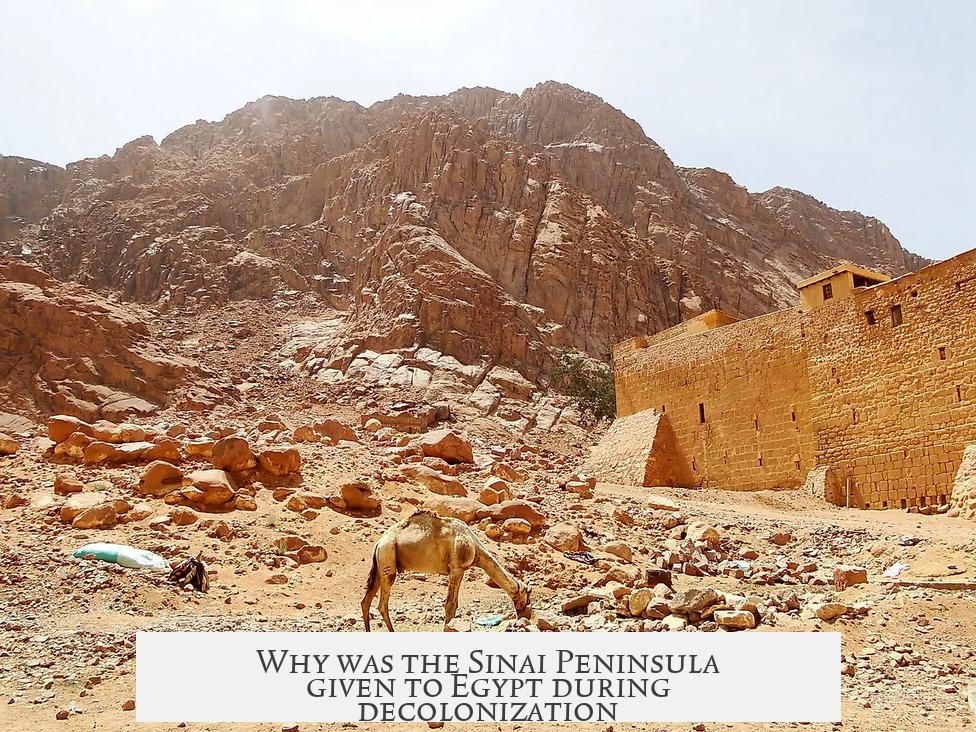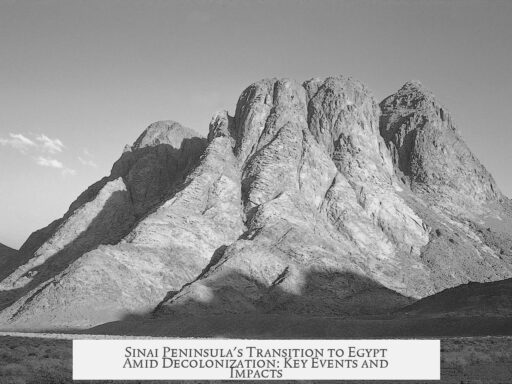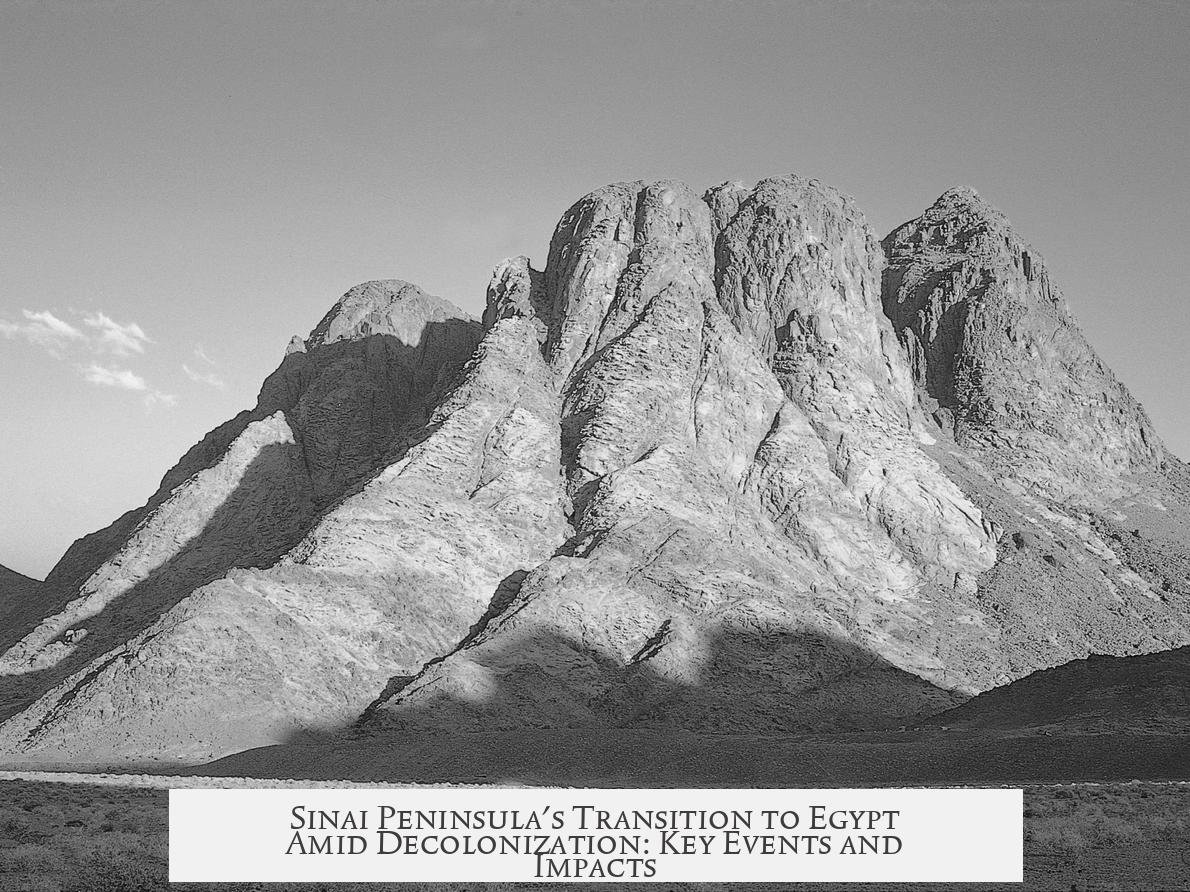The Sinai Peninsula was given to Egypt during decolonization primarily due to a combination of British-Ottoman imperial rivalry and the established Egyptian administrative control over the region. This arrangement aimed to prevent Ottoman military access to the Suez Canal, while formalizing the reality of Egyptian governance over Sinai that existed since the 19th century.
At the turn of the 20th century, the Sinai Peninsula was recognized as part of the Egyptian Khedivate, a status dating back to October 1906. Egypt itself existed as a semiautonomous province under the Ottoman Empire, but British occupation since 1882 complicated the power dynamics. In this setting, the British sought to safeguard their strategic and commercial interests, especially regarding the Suez Canal, a vital route for global trade and the connection to British India.
The immediate trigger for defining Sinai’s status was a boundary dispute in early 1906 involving the town of Taba. Ottoman troops had occupied Taba after British and Egyptian officials withdrew, leading to a naval and diplomatic standoff. The British feared Ottoman expansion aimed at gaining control over key transport routes, including the Hijaz Railway’s possible extension to Aqaba.
The resolution came through negotiations culminating in a boundary agreement signed in Rafah on October 1, 1906. The agreement established an administrative “separating administrative line” along Sinai’s eastern edge. This line was not designed as a hard border severing sovereignty but as an internal delineation acknowledging Egyptian administrative authority while limiting Ottoman influence in the region.
| Actor | Main Objective | Action/Position |
|---|---|---|
| British | Prevent Ottoman military access and protect Suez Canal | Insisted on Sinai as buffer; barred Ottoman troops west of line |
| Ottoman Empire | Limit British encroachment; maintain control over Sinai | Claimed broader authority based on 1841 map; acquiesced after ultimatum |
| Egypt | Formalize existing administrative control over Sinai | Asserted historical governance functions on behalf of Ottomans |
Egypt had performed several administrative functions in Sinai for decades. These included maintaining frontier posts, policing the area, taxing Bedouin tribes, and safeguarding pilgrimage routes to Mecca. Egyptian representatives during the boundary talks underscored that their governance was a longstanding reality. Although nominally under Ottoman suzerainty, Egypt effectively managed Sinai’s affairs as a semiautonomous state led by the Muhammad Ali dynasty since 1841.
The Ottomans based their claim largely on an 1841 map assigning Sinai mostly to the Hijaz province, under direct Ottoman control. However, they failed to provide convincing evidence of an established Ottoman presence or administration in Sinai at the time. The British capitalized on this weakness to bargain for an arrangement that maintained their strategic interests.
The final agreement included a clause prohibiting Ottoman troops from crossing west into Sinai. This was a clear limitation on Ottoman sovereignty designed to protect British interests in Egypt and the Suez Canal. The border was thus an administrative line reflecting practical control rather than a formal international boundary at the time.
The broader reason the Sinai was given to Egypt during decolonization involves the interplay between imperial powers and local governance structures. The British and Egyptians shared an interest in preserving Egypt’s semi-independent position within the Ottoman system. For the British, this ensured Egypt remained a stable buffer against Ottoman influence and protected critical routes. For Egyptians, formalizing sine control over Sinai reinforced territorial integrity and governance authority during a period of shifting colonial landscapes.
- The Sinai Peninsula was historically part of Egypt’s administrative domain since the 19th century.
- The 1906 boundary dispute resolved Ottoman-British rivalry by establishing an administrative boundary favoring Egypt.
- British strategic goals centered on protecting the Suez Canal and limiting Ottoman military influence.
- Egypt established governance functions ahead of 1906, which legitimized its claim over Sinai.
- The Ottoman Empire’s claims were based on historic maps but lacked practical administrative enforcement.
- The agreement restricted Ottoman troop movements and formalized Sinai’s status linked to Egypt.
- Both British and Egyptian interests aligned in securing Egypt’s territorial integrity during decolonization.
Why was the Sinai Peninsula given to Egypt during decolonization?

The Sinai Peninsula was given to Egypt mainly because it served as a crucial buffer zone in the imperial rivalry between Britain and the Ottoman Empire, and because Egypt had already been administratively responsible for the Sinai well before decolonization officially began. This decision balanced British strategic interests with Egyptian administrative realities under the Ottoman system.
Let’s unpack this fascinating historical puzzle with some rich context and details that show just how geopolitics, imperial rivalry, and local governance all intertwined to decide Sinai’s destiny.
Setting the Stage: Early 20th Century Sinai Status
Imagine the early 1900s. The Sinai Peninsula is officially part of the Egyptian Khedivate as of October 1906, nearly 50 years before post-WWII decolonization kicks in. Egypt itself is a unique entity: an Ottoman province with a semi-autonomous regime, governed by a hereditary dynasty. But—and here’s where it gets spicy—Britain has been occupying Egypt since 1882. Talk about complicated sovereignty.
Sinai wasn’t just a barren desert; it was a strategic land bridging Africa and Asia, pivotal to controlling the Suez Canal and pilgrim routes to Mecca.
A Boundary Dispute Sparks Imperial Drama
The core of the issue begins with a town called Taba. In January 1906, a dispute over Taba escalated tensions dramatically. Ottoman troops were already stationed at nearby Aqaba, and when British and Egyptian officials tried to assert control, they were told—in no uncertain terms—to get lost. The Ottomans then occupied Taba itself, triggering both naval standoffs and diplomatic turmoil. Sounds like a historical soap opera, right?
Eventually, the Ottomans relented in May 1906 after a British ultimatum and agreed to negotiate the Sinai question. The result was a boundary commission that created a “separating administrative line” along the peninsula’s eastern edge, essentially balancing Ottoman and British interests without triggering outright war.
The Actors and Their Goals: Not Just a Simple Land Swap
- Ottoman Goals: Keep British influence at bay. They wanted to prevent Egypt from fully detaching from Ottoman control by reasserting sovereignty over Sinai through direct presence.
- British Goals: Keep the Ottomans out of Sinai. Protect the Suez Canal, which was a lifeline to India and beyond, and secure global commerce routes.
- Egyptian Role: Egypt, though under Ottoman rule, had effectively governed Sinai for decades. They managed frontier posts, police stations, and taxed local Bedouin tribes—all on the Ottoman Empire’s behalf.
This wasn’t simply about maps. It was about control, commerce, and imperial influence.
The Egyptian Claim Was More Than Wishful Thinking

By the turn of the century, the Egyptians were running Sinai administratively. Muhammad Ali Pasha—an iconic figure credited as the founder of the Egyptian hereditary dynasty—was officially recognized in 1841 as the authority over Sinai. Egypt had been safeguarding critical land routes, including the pilgrimage to Mecca, and maintaining order in the region.
Egyptians argued they had acted “on behalf of the Ottoman state” by administering the Sinai. Their case was bolstered by effective control, not just vague claims.
The Ottoman Response: A Skeptical Eye
Of course, the Ottomans weren’t going to give up easily. They presented an 1841 map, often called the “first map of modern Egypt.” This map clearly shrank Egypt’s claimed boundary, limiting it to a small triangle in northwest Sinai. Most of the peninsula was shown as part of Ottoman-administered Hijaz.
However, the Ottomans struggled to prove they had real, sustained administrative or military control over Sinai. Essentially, they had the title, but not the presence or infrastructure to back it up.
The 1906 Boundary Agreement: Redrawing Sinai’s Fate
Finally, on October 1, 1906, the British and Ottoman officials signed a boundary agreement in Rafah. The key points were:
- The boundary was an administrative line, not a political border splitting Egypt from the Ottoman Empire. Both sides wanted to preserve this façade of unity.
- Crucially, a British clause prohibited Ottoman troops from crossing west of this line into Sinai, effectively limiting Ottoman sovereignty there.
This arrangement kept the peace but heavily favored British strategic interests, ensuring Sinai became, in practice, Egyptian and British-controlled territory.
Why Does This Matter?
The Sinai Peninsula’s transfer wasn’t a random act of colonial generosity. It was a calculated move in a game of empires. The British wanted to shield Egypt and the Suez Canal from Ottoman influence or military threat. The Egyptians, meanwhile, aimed to formalize the reality on the ground, legitimizing their control over Sinai that had silently grown for decades.
You could say the British and Egyptians formed a sort of low-key alliance—each had a vested interest in keeping Egypt intact within the Ottoman framework while keeping the Ottomans themselves at arm’s length. This delicate balance played out through the Sinai arrangement.
What Can We Learn from This Story?

First, it’s a reminder that decolonization and territorial control often involve complex legacies rather than neat “give and take” situations. Borders get drawn through negotiation, power plays, and realpolitik rather than simple morality.
Second, the importance of administrative presence over mere claims shines through. Egypt’s prior governance—managing police funds, taxing locals, protecting pilgrims—gave its claim credibility that a map alone (like the Ottoman one) could not match.
Finally, it highlights the strategic importance of geography. The Sinai Peninsula wasn’t just desert land; it was a lifeline for commerce through the Suez Canal and a battleground for imperial ambitions.
A Quick Comparison: Sinai Then and Now
| Aspect | Circa 1906 | Modern Times |
|---|---|---|
| Administrative Control | Egypt administered Sinai on Ottoman behalf, British influence high | Egyptian sovereign territory; strategic buffer zone |
| Military Presence | British and Egyptians kept Ottomans out; Ottoman troops barred | Egyptian army secures area; complex regional security environment |
| Strategic Importance | Key to protecting Suez Canal and pilgrim routes | Still vital for trade and military between continents |
Wrapping It Up
The story behind Sinai’s handover to Egypt during decolonization is a masterclass in imperial chess. British goals protecting global commerce and Egypt’s asserted administrative role combined to create a lasting arrangement. Ottoman ambitions were checked by real control and smart treaties. It wasn’t just geography that assigned Sinai to Egypt—it was a web of power plays, treaties, and centuries of evolving governance.
Feeling fascinated? Next time you gaze at a map, remember: every boundary line hides stories of rivalry, negotiation, and unexpected alliances. Sinai’s story is one such tale, carved not just in the sand, but in the pages of history.
Why did the British want the Sinai Peninsula under Egyptian control?
The British aimed to prevent Ottoman military access to the Suez Canal and Egypt. The Sinai acted as a buffer zone, protecting important trade routes, especially routes to India. This served their global strategic and commercial interests.
How did Egypt’s administration impact the decision on Sinai’s status?
Egypt had long managed Sinai’s local affairs, like policing and collecting taxes. These administrative responsibilities supported Egypt’s claim to the peninsula, making it logical to keep Sinai under Egyptian control during decolonization.
What role did Ottoman-British rivalry play in determining Sinai’s fate?
The British-Ottoman rivalry shaped the boundary. The British wanted to limit Ottoman influence, so they negotiated an administrative boundary favoring Egypt. Ottomans accepted a line that prevented them from stationing troops west of Sinai.
Why was the 1906 boundary agreement important for the Sinai Peninsula?
The agreement formalized Sinai as part of Egypt’s administrative area. It ensured Egypt kept control but maintained Ottoman suzerainty officially. This helped balance imperial interests while avoiding direct Ottoman military presence in Sinai.
Did the Ottomans have a strong claim to the Sinai Peninsula before decolonization?
The Ottomans cited maps and historical ties but lacked evidence of direct control over the Sinai. Their claim was weaker compared to Egypt’s longstanding local administration, which influenced the boundary outcome favoring Egypt.




